Olynthus
Q1141669Olynthus (Greek ῎Ολυνθος): Greek town on the Chalkidike, southeast of modern Thessaloniki. It is best known as capital of the Chalkidikean League.
History
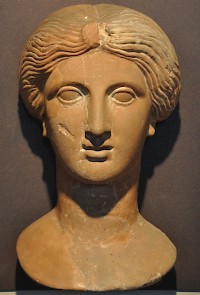
Olynthus lies on two hills east of the winter torrent Sandanos in the southwestern Chalkidike. There are remains from the Late Neolithic period, but the site appears to have been abandoned and remained empty until the eighth century BCE. According to the Greek researcher Herodotus of Halicarnassus, the town was taken over by Bottiaians who had been driven away from the northern shore of the Thermaic Gulf by early Macedonians.note.
The city was named after one Olynthus, who was killed here after a hunting accident, and was believed to be the son of either the river god Strymon or the demigod Heracles. The town was located about sixty stades (some eleven kilometers) from Potidaia and twenty stades (3¾ kilometers) from Mekyberna, and had a harbor at the head of the Gulf of Torone, between the Pallene and Sithonia peninsulas.
Herodotus also tells that the Persian army of Artabazus attacked the city in the winter of 480/479, killed its population and handed it over to Greek settlers from the Chalkidike, who were led by one Critobulus of Torone. The city became the most important of the Greek colonies on the fertile peninsula, and was a member of the Delian League (the Athenian alliance), paying two talents of tribute every year.
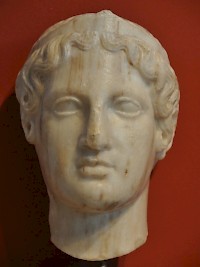
In 432 BCE, the Chalkidikean towns revolted and formed a powerful federation, with Olynthus as its capital.note This was one of the causes of the Archidamian War (431-421), during which many Greeks moved away from their settlements along the coast and settled in Olynthus. The expansion of the city was planned. The independence of the city was guaranteed in the Peace of Nicias.
The city became one of the most important cultural centers in Greece. Among its inhabitants were Callisthenes and Ephippus, who both wrote about Alexander the Great.
In 382, the Chalkidikean League attacked Macedonia. This resulted in a Spartan intervention, the surrender of Olynthus, and the dissolving of the alliance. It was reorganized, and allied itself in 358/357 to king Philip II of Macedonia, who recognized that Potidaea belonged to Olynthus. However, the relations deteriorated when the Chalkidikeans concluded a peace treaty with Athens.
War broke out in 349. The Athenian politician Demosthenes argued for rapid and massive intervention, but the Athenians responded slowly and with insufficient troops. In 348, Philip besieged Olynthus, bribed his way into the city and sacked it.note
Arrowheads and slingstones are evidence of the destruction. The territory was later given to Potidaea when it was refounded as Cassandreia (316).
 Olynthus, Slingstones with inscription |
 Olynthus, Arrowhead with inscription "from Philip" |
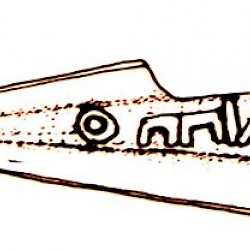 Olynthus, Arrowhead with inscription "from Philip", drawing |
 Olynthus, Coin with a cithara |
Archaeology
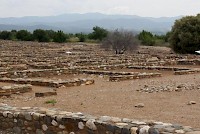
Philip's action in effect secured the remains of Olynthus from oblivion, since the city was never refounded. The ruins provide a rare chance to walk through the residential streets of a classical Greek city. The site offers the best evidence there is for Greek houses of the late fifth and early fourth century BC.
Olynthus occupied two hills. The most interesting excavations are on the northern hill, where the Olynthians laid out a large area of new housing on a regular plan near the end of the fifth century BC. This extension was planned in rectangular blocks traversed from north to south by "avenues". Each block is made up of two south-facing rows of five houses, separated by a narrow alley for drainage. Over a hundred houses have been excavated. Although they are similar, no two are identical.
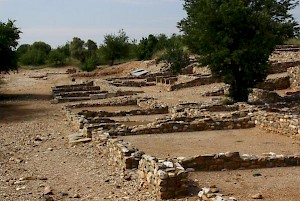
The houses had mudbrick walls (destroyed) on stone footings. Apart from bathrooms, some houses have a room with a stone-curbed hearth and an associated air-vent, presumably where cooking took place. The other readily identifiable space is the "room of the men" or andron, where male inhabitants received other male guests for meals and drinking.
About one third of the houses had bathrooms, sometimes preserving fired-clay baths, not for immersion, but for washing in a sitting position with heated water.

Some houses had beautiful mosaic floors. One fine example shows the hero Bellerophon, wearing the Macedonian sun-hat or petasos and mounted on his horse Pegasus, spearing the monstrous Chimaera, shown with a lion's body and head, a snake's tail and a goat's head sticking up from its back.
Getting there
Olynthus is situated about eighty kilometers southeast of Thessaloniki on the Chalkidike peninsula and can easily reached by car.
 Olynthus, Bathtub |
 Olynthus, Geometrical mosaic |
 Olynthus, Mosaic of Bellerophon, Griffins |
 Olynthus, Mosaic of Bellerophon |